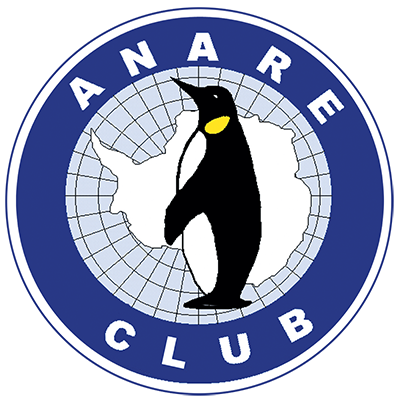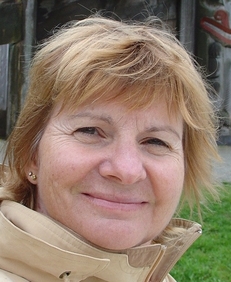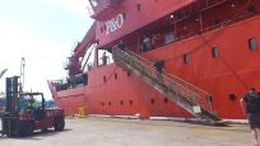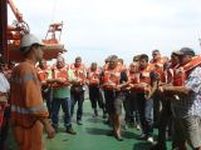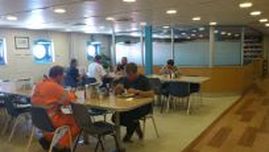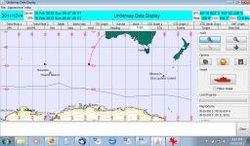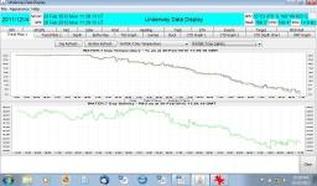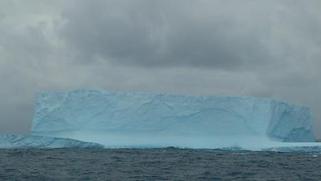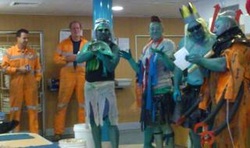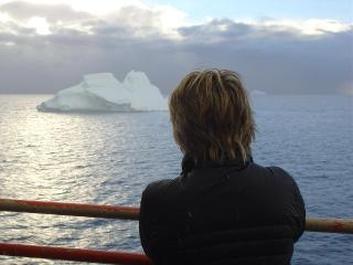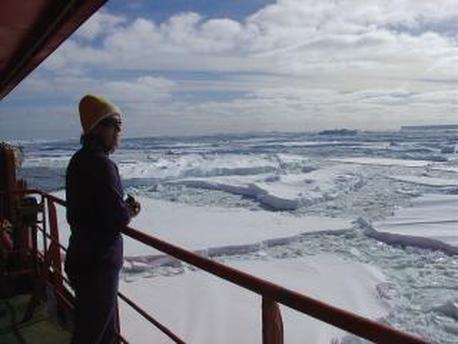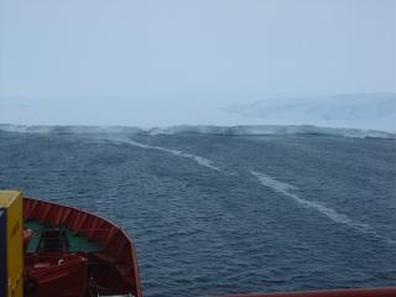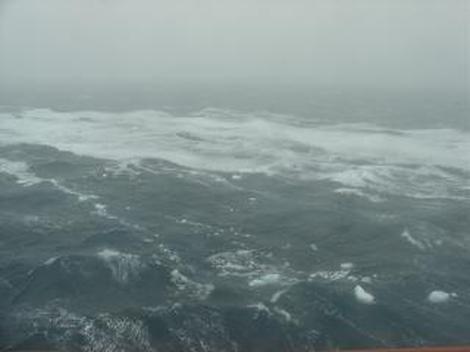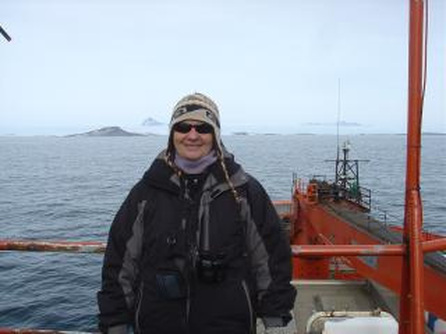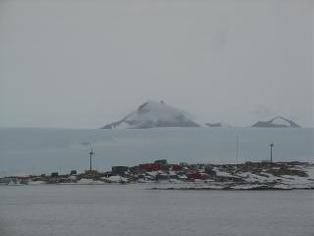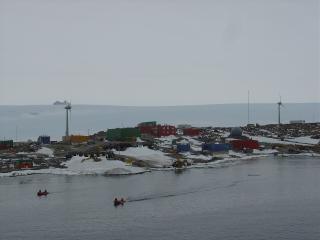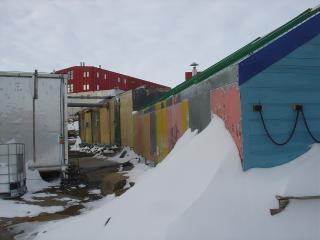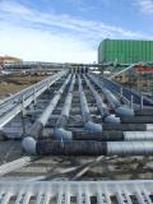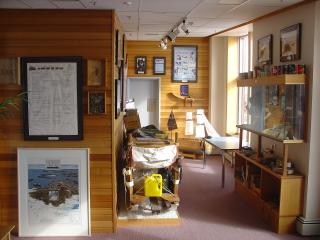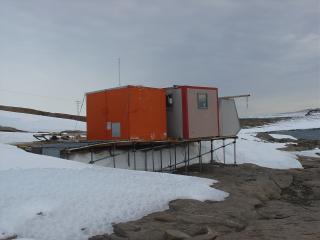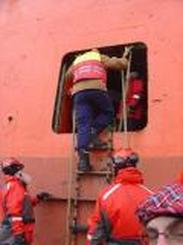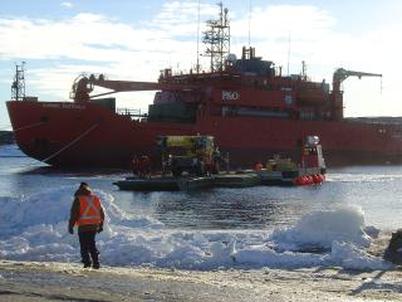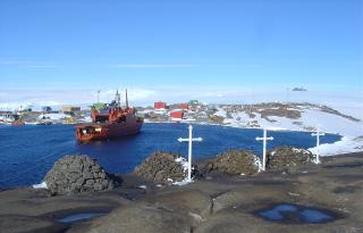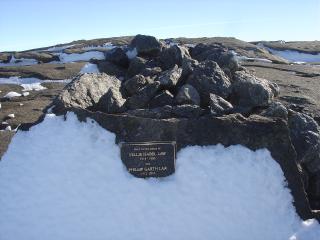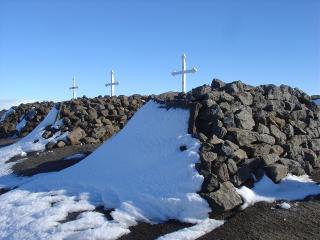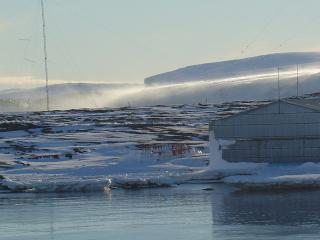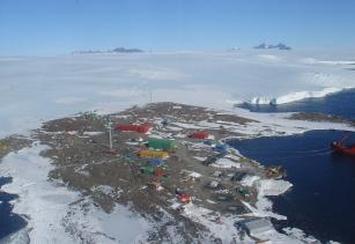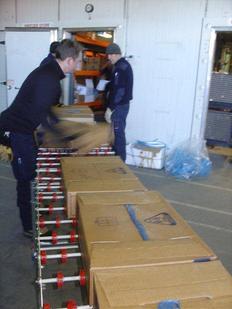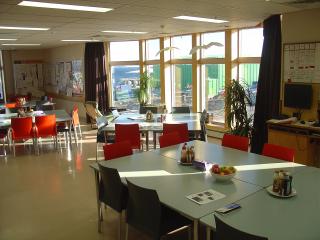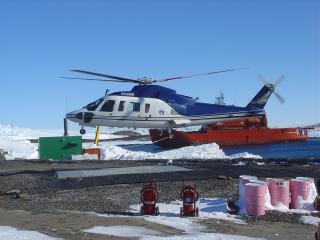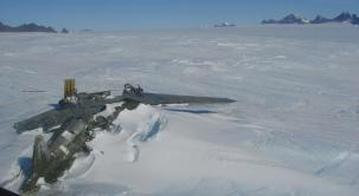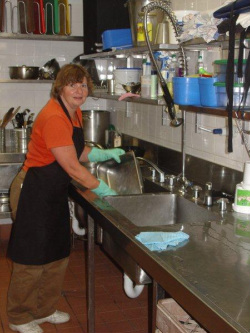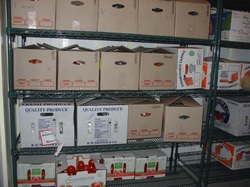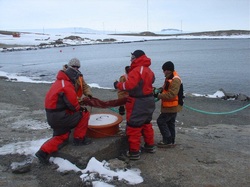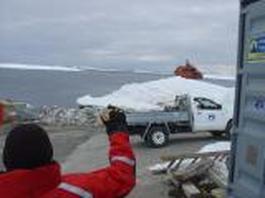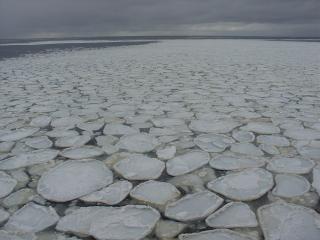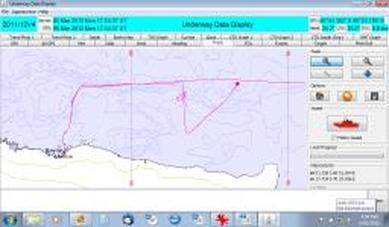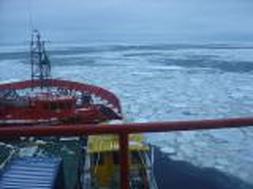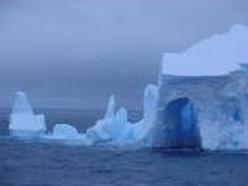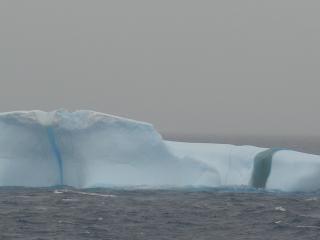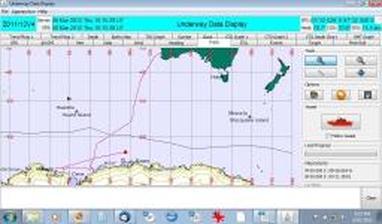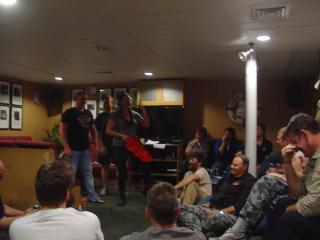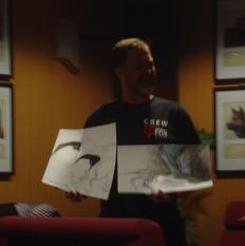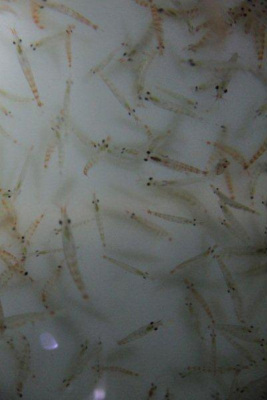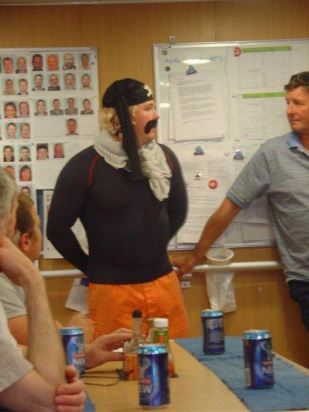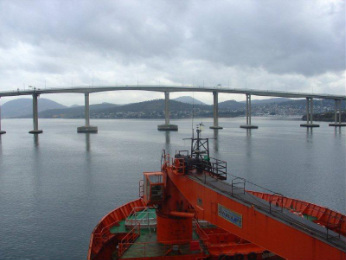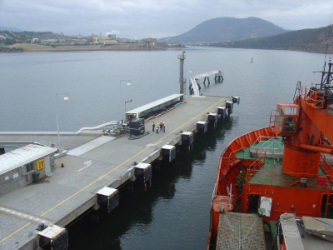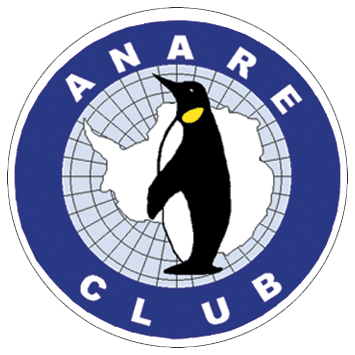ANARE Club Representative Voyage 4
Depart Fremantle 15 February 2012
Anare Club Berth Report. Mawson Resupply.
Wednesday 15 February. – Sailing day.
Departure procedures are now a well organised logistical exercise in group people management and luggage movement. We were advised by email and sms phone messages on Monday evening – well in advance of the sailing date about departure arrangements. ‘Meet at the hotel at 9.45am to be transported to the ship by bus. Bags must be no heavier than 15kg, ensure passports are handy for customs and hands are kept free for boarding the gangway’.
Then passport processing by customs and a series of briefings commenced on board, while the bags were lifted to the helideck for collection afterwards. All very different, and much easier, from the days of struggling up the gangway several times with heavy bags full of clothing kit.
The briefings included ship safety, lifeboat and muster drills and a medical briefing focussing on seasickness. This was informative – without the flair of Dr Gormly’s famous series of slides showing the Dan ships rocking and rolling on the southern ocean. First to the left and then to the right and so on. In fact, I recall one year an expeditioner seated near me fainted during
one of those talks – already feeling seasick and dreading the forthcoming southern ocean. Change is always happening. Whether it be climate change, social change or just us getting older and this change is certainly evident in port security procedures in today’s world. Aurora Australis could be seen in port across the river from Fremantle – at a distance.
There is no longer the casual visits prior to sailing, showing family and friends over our cabin or having a meal on board in the dining room before departure. Wharfside music farewells with streamers, thrown by family and friends on the wharf, stretching to breaking point as the ship slowly moved away are now a memory of the past. We waved farewell to the three staff members of the AAD who assisted with cargo loading and were standing near their vehicle on the wharf and then walked around the heli deck with mobile telephones to our ears, talking to loved ones as we watched a smoky-skied Fremantle fade into the distance in the afternoon sun.
Thursday 16th February – Day 1
The ocean is a ‘millpond’ as we head southwestards through a high pressure system. In fact I woke once and wondered whether we were actually moving – the ship was so steady. A perfect first day out for us to gain our sea-legs.
Muster briefing, with all our emergency kit, was the main activity for the morning. Then after ensuring my ship email was functional, I settled into familiarising myself with the ANARE Club recording equipment, the expeditioner list compared with our membership list and I also commenced preparing an ANARE Club talk for the evening lecture series.
The variety of food on offer by the galley is magnificent, as usual, and three hot meals a day will see me needing to do more more walking around the ship. On previous voyages as a Bureau of Meteorology employee, I was required to do 3 hourly meteorological observations and monitor satellite imagery. This required walking the stairs from E deck (the dining room) or D deck (the cabins) to the bridge on A deck regularly several times a day – four or five flights of stairs each time.
Instead as an ANARE Club representative, I enjoyed a half hour circuit around the heli-deck with the boat rising and falling in the slight seas, producing the apparent motion of walking uphill and downhill in short bursts. The air temperature is balmy at around 20C and 85% humidity with a westerly wind of around 15knots. A very pleasant day.
At 1500 Australian Eastern Standard time we were at -34 01 S, 111 44 E with slight seas and low swell. Tonight’s lecture is Sharkwater followed by ‘The Girl with the Dragon Tattoo’. We are heading southwest along the ridge at about 13 knots, hoping to reach far enough south to avoid a deep low pressure system approaching from the west.
17th February – Day 2
Clocks were retarded an hour overnight, as we continue to head southwestwards in fine conditions and mostly blue skies. The daylight hours are starting to lengthen as we head southwards. We are now four hours behind the eastern states at the moment.
The seas have risen slightly to 2m and it is noticable that we need to keep a steady footing and follow the water around in the shower due to the ship’s movement. Throughout the day we continued to sail in slight seas and low swell and are currently at 40 08S 107 04E.
Let me introduce some other members of the voyage.
Firstly we have the ingoing Mawson wintering team consisting of doctor, chef, field training officer/storeperson, plumber, carpenter,mechanical, electrical, meteorology and communications staff. They have a long term outlook – It will be about a year before they return to Australia and they can be seen enjoying the fresh fruit and salads at mealtimes – keeping in mind that these will not be readily available all year.
The remainder of us are on the round trip voyage – just a month away from family and friends at home, fresh fruit and cafes. Two of these are ANARE members who first sailed from Fremantle to Antarctica forty years ago as members of wintering teams. Congratulations and credit to Dave McCormack and Graham Mills for remaining fit to pass the stringent medical requirements and continuing to work in the service of Antarctic programs.
We have the AAD voyage management team – Voyage leader, Deputy Voyage leader and a voyage management trainee and the helicopter crew – pilot, engineer.
A Navy Hydrography team are on board hoping to accurately obtain a bathymetric map of the Mawson harbour and surrounds.
We have the WAGS – no – it is not the ‘Wives and Girlfriends’, as the Antarctic Wives and Kinsfolk were once known, in the days when expeditioners were only the ‘Men of ANARE’. It’s the Water, Aircraft Ground Support group.
We have the refueling/resupply team, some AAD office personnel, ship-air ops communications crew and a few round trippers who projects I am yet to determine.
And lastly – but not least the ship’s Captain, officers and crew who are working 24 hours around the clock to get us and our cargo to and from Antarctica safely.
Several briefings are held for various groups throughout the day including field training (rope & navigation) for the wintering team, then a lecture followed by a movie is the program for the evening. Tonights lecture was Vostok 600 – traverse to Vostok in 1962.
This is interspersed with meal-times three times a day and the food variety and selection is of a very high standard.
I have booked the Sat 18th lecture timeslot as the ANARE Club representative. The title is ‘No Email- One female” and will be espousing the fellowship and principles of ANARE. Rod McKenzie’s poem, ANARE MAN, as printed in the History of ANARE will be a feature. I hope I can do any of his renditions justice.
Happy Birthday Big Bro! Hope you are celebrating in style.
Saturday Feb 18th – Day 3
We still have relatively smooth sailing for passenger comfort – although a 2.5m swell is beginning to reach us from a low to the west so there is more ship movement and walking the heli deck has become too risky. We are now at 45 10 S 104 15 E (about Hobart’s latitude), the temperature is around 13C and the winds have turned northwest and freshened to 25kt and skies are mostly overcast. We are starting to see some seabirds around the ship and the day’s activities included scrabble (which incidently I won – just lucky) and a talk that I presented promoting the Anare Club. Navigation exercises were the highlight for ingoing expeditioners.
We have received a meeting program for the next week -with our anticipated arrival at Mawson currently next Saturday (one week away). It includes Environment briefings and vacuuming and boot scrubbing so we do not take ‘alien’ species into Antarctica. – but more on that later
Sun 19th Feb – Day 4
Almost at 50 S 102 E. Shipboard routine is settling in. The sky has turned grey and a side swell has the ship rolling up to 7 deg. This is not much compared to the 30 or 40 deg roll of the Dan ships – but still very significant for the Aurora Australis. We are continuing to head southwest and are almost nearing Heard Island’s latitude. The northwesterly wind has increased to 25 knots as we near a frontal band. The air temperature is 8 degrees C and the sea temperature just under 6 C. We have been advised to ensure items are secure tonight, as it is expected to get a bit ‘bumpy’,
Our individual Special Projects meetings were held today in the Voyage leader’s office. These are agreements between the AAD and our organisation (for me – the ANARE Club), regarding each of our responsibilities. Given good weather conditions, I should be able to get ashore at Mawson for a short time and take a walk on West Arm to the interrment location of Phil Law’s ashes.
The sea ice imagery is indicating very little pack ice or fast sea ice on the Mawson approach, so hopefully we will cruise along iceberg alley into Horseshoe harbour without any problem.
Tonights lecture – Abalone industry.
Mon 20th Feb – Day 5
The wind and seas picked up overnight creating some ship movement, however with mostly abeam or following seas, the ship remained fairly comfortable and sleep was mostly undisturbed. Then during the afternoon, conditions returned to a smooth sea and slight swell and walking became easier again.
We passed through the antarctic convergence with the sea temperature cooling to 3 degrees and the ocean salinity falling slightly. This is an ocean current that circumnavigates Antarctica. This ocean current has lower salinity, due to the melting of fresh Antarctic ice and sea ice. Some salt leaches out of the seaice during the freezing process and throughout the winter period. Permanent ice can be found on islands to the south of this oceanic current and iceberg sightings now become more likely.
The sweep for sighting the first iceberg has commenced with half the proceeds going to the winner and half to Camp Quality – the charity that the ship supports. Lynie, one of the galley staff celebrated a birthday so there was plenty of cake available today and the menu continues to be of a high standard.
Environmental and wildlife approach distances were the features of today’s information sessions and tonight’s lecture is ‘Blue Ice’ – a film produced about the establishment of Mawson in 1954, starring a young Phil Law, Bill Storer as the 1954 Mawson wintering postmaster and Dick Thompson as the flagbearer in the Vestfolds. Some Russian and Indian Antarctic footage from 2010 and 2011 were also shown during the evening session.
Tues Feb 21 – Day 6 – Iceberg ahoy
The ship rolled up to 15 deg today in moderate seas earlier today, but has settled back to a nice steady movement again in the evening. The air temperature and the water temperature are both now 2 deg. Winds are from the south at about 20 knots today.
There was much excitement about today and the cameras came out in force as icebergs and floating growlers and bergy bits were spotted. Jackets, boots and bags that are to be taken ashore were scrubbed and vacuumed to ensure no alien plant material is likely to be taken ashore to Antarctica.
Tonight’s lecture was titled ‘The AGSO’s other lives’. This is the Air Ground Support Officers who are involved in police and military helicopter support in Australia and overseas. It was a fantastic informative session and I am always impressed by the variety of skills and activities of the other members of the voyage.
Wed Feb 22 Day 7 – 60S – Neptune
Smooth sailing all day with light snow showers between sunny breaks as we head southwestwards towards Mawson. The air temperature is 0 to minus 0.5 deg C – and below the water temp of 1.5C at the moment, winds are from the northwest again at around 15 knots.
Our planned arrival time of around noon on Saturday 25th February has been delayed until possibly Sunday evening or Monday morning due to a forecast deep low pressure system, which is expected to be near Mawson on Saturday and Sunday. This low is expected to produce average winds of around 50 knots (approx 100 kph) and gusts to 70 knots on Saturday afternoon and evening. Timed with our expected arrival this would make conditions dangerous for entering and setting out the mooring lines to safely anchor in Mawson harbour.
We passed through 60S today – the imaginary line of latitude representing the Antarctic waters and the ship was ‘visited’ by King Neptune and his cronies (court) ‘welcoming’ us all into Antarctic territory. We all had to kneel and call “Hail the King” several times’. Then first- timers were asked to kiss the fish, bow at King Neptune’s feet to honour him, consume the salty sea and then were ‘blessed’ with mud from the bottom. Two ‘old-timers’ on their 40th year were also asked to honour King Neptune i.e subject themselves to the process also. Somehow, I think they should have been carried on shoulders high instead, for providing 40 years of good service to Neptune.
The afternoon scrabble game was special to me – I managed a double – triple point score in one go – using all my letters. I do not think I have ever done this before. I was so excited I could barely add up the points. Admittedly it was with a local rule that blanks could be swapped with a letter of the same value and must be used immediately. I LIKE that rule.
Tonights lecture was Weasels – (Antarctic tracked vehicles from the 1950’s-1960’s) and how they came to be used in Antarctica. One of these vehicles broke down and was left on a traverse to the Prince Charles mountains in the early 1960’s. In the 1990’s Dave McCormack had a project over a few years to attempt to find this vehicle, which is still located in the ice inland from Mawson.
Another weasel depoted during the late 1950’s was recovered in 1988 and restored in the early 1990’s and is currently located at the Antarctic Division in Hobart.
Thur 23 Feb Day 8
An indoor special function ‘BBQ’ was held last night after the arrival of Neptune and his court – so we all enjoyed an ale or wine with our meal, if desired. As an alcohol-free voyage, apart from special functions, this is the first alcohol seen since leaving Fremantle a week ago.
The clocks were retarded another hour overnight so we are now five hours behind the southeastern Australian states and are currently an hour ahead of Mawson’s local time. We have altered course to track more southwards due to a deep low pressure system which is expected to affect the Mawson area over the weekend. This has delayed our arrival at Mawson until after Sunday.
The air and water temperature is hovering around the zero degree mark and light snow showers with short sunny breaks have been a feature of the day. The bridge is popular now with frequent icebergs and whales being spotted and cameras are out in force now.
The beanies and gloves have also come out to enable us to stand outdoors for photos.
One pod of whales had both humpback and small fin pilot whales together which we thought was quite unusual. Plenty of bird life is still following the ship with prions, shearwaters, giant petrels, cape petrels (sometimes called cape pigeons) about. There was still time to enjoy a game of scrabble during the afternoon.
Tonight’s lecture was “Law of the jungle” – 30 years of protesting in the Tasmanian forests – a policing perpective.
Friday 24 February – Day 9
Todays highlight was the delight of waking to find we were moving through open pack ice. The pack ice is one of my favourite parts of any Antarctic trip. The swell and seas of the open ocean are damped out by the ice. The ice today mostly consisted of small first year sea ice floes (around to 20-50 metres across) which are remnants of the large floes, that developed during the winter.There were also frequent icebergs. There was some new ice formation occurring in places between the floes, such as small pancake ice, grease ice and nilas.
Today there was wildlife galore, emperor, adelie penguins, crabeater, weddell and leopard seals – all lazing on the ice floes enjoying the sunshine, plus a whale or two being spotted in the evening light. Today’s temperature was about minus 3 dec C with a water temperature minus 1.5 C and southwesterly winds to around 12 knots. So it was a very pleasant day out on deck with a warm hat, gloves and coat watching the magnificent scenery pass by. Sunscreen and sunglasses were a necessity too. All in all, a magic day today moving through the pack ice in Prydz bay. The track looks like we are heading to Davis as the ship headed into the pack to avoid a deep low expected to hit Mawson area on Saturday afternoon – Sunday and produce rough seas.
Briefings still continued throughout the day, with familiarisation with helicopter operations procedures the main briefing of the day. All were required to attend. We have a S76 helicopter and crew on board, should helicopter operations be required. After the video about helicopter safety was shown, we all visited the helicopter hanger and became more familiar with the machine. This helicopter carries 8 passengers, so we were each seated inside, whilst instructions about safety, doors, emergency exits, life jackets, seat belts, movement near helicopters and such was received.
Saturday 25 February – Day 10
The crew held exercises today with the FRB (Fast Recovery Boat) and lifeboat. Several individual briefings are occurring in readiness for the Mawson resupply and a muster and Mawson medical team exercise was carried. We were all rugged up for the muster with the air temp at minus 8C, a northeast wind of 15 knots producing a wind chill of minus 18. This is certainly not the weather one wants to be standing around on the heli-deck for long periods without warm clothing.
Tours were held through the engine room today in small groups of four or five. There is the functioning of a small city in the bottom of the ship. This includes a power house – with three electricity generators (of which only one is needed at the moment), two engines providing power for the drive shaft and propeller, a desalination plant and a reverse osmosis plant producing fresh water for the ship, a boiler for steam production, a vacuum sewage collection and treatment system, steering mechanism, thruster mechanisms. All in all – very complex network and a credit to all the staff working there that keep the ship functioning.
We have remained near the West Ice Shelf in the eastern side of Prydz bay to shelter from a deep low pressure system. This system is expected to produce winds to 30-40 knots (~60-80 km per hr) near us with heavy snowfalls reducing the visibility. After a sunny start with early morning sea fog the cloud lowered and thickened all day and currently we are in 25 knot easterlies in a sheltered area with very darkened cloud to the west. The winds were already 50 knots at Mawson with blowing snow before noon and this had been our expected arrival time when we departed Fremantle. Now, the expected arrival time has been delayed until Tuesday, due to the presence of this low in the area over the next few days.
Tonight’s lecture was the BBC production of Nansen’s attempt for the north pole in the Fram. This ship was later used by the Amundsen to conquer the south pole and can still be visited in Oslo today.
Sunday 26 February – Day 11
The wind averaged 40 knots most of the day and the temperature around minus 3C, snow and poor visibility. We sailed in the shelter of the West ice shelf until later in the day and have now started to move westwards again, hoping to arrive by the time the weather eases on Tuesday. Mawson experienced around 70 knots today. The outdoor decks on the ship were closed. Those going outdoors for work were required to report to the bridge first. Some were involved in field training exercises to experience the windy conditions and test their clothing kit.
The BBC series continues at the 7 pm lecture time and tonights episode on Airships was well attended, without any competition from the outdoor scenery tonight.
Hope all is well at home. We are about 2 days behind schedule now.
Tuesday 28 February – Day 13
We cruised down iceberg alley and into Kista Strait in light winds and mostly clear skies. Today’s webcam from the ship and from Mawson would have made great viewing. The Frammes mountains came into view. Firstly Mt Henderson, then the Northern Massons the David range and finally the Casey range. What an awesome sight to see these mountains poking out from the 1.5 km thick icecap. My first visit to Mawson was via the helicopter in approaching bad weather and the second time we were involved in briefings – so I had never really enjoyed this magnificent sight. There appeared to be some blowing snow on the plateau, producing a fuzzy base to the mountain ranges.
We stopped in Kista strait while the station leader and a few others from Mawson came out in inflatable boats and the jet barge was unloaded. The WAGS (Water, Aircraft Ground Support) crew returned to shore in the inflatables and the jet barge, Bill Budd, was unloaded to assist the laying of the mooring ropes. Then we slowly moved into Horseshoe Harbour and completed the mooring process.
The 2011 wintering station leader briefed us on the do’s and don’ts of Mawson operations. West Arm is out of station limits these days and requires station leader permission, a radio and intentions notification. This was once an evening walk for me.
Some of the wintering and high priority personnel, mail and some fruit and vegetables departed for shore, while the remaining wintering crew and round trippers remained on the ship overnight. Unloading operations and round tripper programs will commence in earnest tomorrow.
Wednesday 29 February – Day 14
At 9 am we were all packed with our day survival packs, wearing full outer gear, ready for boarding the barge to go ashore. This routine has been developed into a smooth operation. We all gathered in the library area of the ship, turned our name tags on the fire board to indicate leaving the ship, filed through to the conference room, collected our lifejackets and when advised climbed down the hatch ladder onto the barge. This precedure is reversed on arrivng back on ship later in the day.
We were met at the wharf area by the 2011 station leader, Mark, and given a short tour of the station and the ‘red shed’ living and medical facility. This also involved marking that we had arrived on station on the intentions board. I was advised there would be no walks on West Arm today and East arm is also out of bounds due to antennae being down in the 90 knot blizzard a few days ago. Between assisting in the green store with some cargo I was free to walk around within the station limits. I explored the old station again and visited my old rooms and work places. The station has changed very little since 2005 with only one new field store, but is quite different from 1986. Biscoe hut at the end of the old station chippy’s workshop has been refurbished after a fire damaged it in about 2002.
So it was a day of old and new, including a walk along the old dog lines and through the old station buildings. The seal meat dog feeding hut still smells as if the seal meat was removed yesterday. One of my favourite spots is the husky room in the upper end of the Red shed living quarters which has a packed dog sled and husky memorabilia and magnificent views across West Bay. It was a glorious sunny afternoon with light winds and I caught the 6pm barge back to the ship for dinner.
Thursday 1 Mar – Day 15
We woke to a perfectly calm day after a clear night with small pancake ice forming around the ship. The night had been cloud free and some had been watching for auroras. The ship was recording a light southerly wind at 5 knots, without any katabatic but this could be seen across east bay with the snow drifting off the plateau. Those staying on the ship headed ashore on the barge to continue their projects or to help out with any cargo in the green store. All the winterers are now ashore and a few of the summering personnel have arrived on the ship. So there are a few new faces at mealtimes now.
So it was a day of old and new, including a walk along the old dog lines and through the old station buildings. The seal meat dog feeding hut still smells as if the seal meat was removed yesterday. One of my favourite spots is the husky room in the upper end of the Red shed living quarters which has a packed dog sled and husky memorabilia and magnificent views across West Bay. It was a glorious sunny afternoon with light winds and I caught the 6pm barge back to the ship for dinner.
Friday 2 Mar – Day 16
A corker of a day weatherwise – perfect sunshine all day, light winds without a cloud in the sky. Containers were coming ashore in a steady stream to resupply the 2012 wintering team. A few of us had been briefed in the morning to pack for a possible overnight in a field hut and to be ready and available during the day in the green store for unloading the containers. We turned our fire tags to show that we were leaving the ship and headed ashore.
The first part of unloading is with machinery. The containers are unloaded from the ship onto the barge, transported to the shore, lifted by crane onto a skidder and driven to the required location and placed nearby by the Cat 950. Then the manual labour takes over. The frozen meats and vegetables were the first container to be opened. An extendable roller system is used to assist in transporting the cartons from the container to the freezer. Cartons are lifted onto this racking, then pushed along to the end and unloaded a placed on the shelving. Some cartons roll well – others keep getting stuck. Another container held the fresh fruit, vegetables, potatoes and onions. These required placing in different locations, including manhandling the cartons up stairs in a chain gang. Carrot boxes are heavy! This was all good exercise after two weeks of inactivity on the ship and it was good to feel of assistance to the wintering team.
In the meantime the refuelling crew had started pumping special Antarctic blend diesel from the ship to the fuel tanks onshore and this was going smoothly at around 50,000 litres per hour. This fuel will keep the station running during the year.
It was my turn to stay ashore overnight. So after a relaxed meal I enjoyed a locally brewed ginger beer, whilst reminiscing with some of the outgoing crew.
At 1030pm an aurora australis (southern lights) started to develop in the cloud free sky, putting on a spectacular display of green and red and was enjoyed by many. The aurora is about 100km up in the ionosphere but when it dances across the sky it seems as if one can touch it. Truly a magnificent sight and we were given a wonderful display.
Saturday 3 Mar – Day 17
Unloading continued in the green store. Today it was all the warm store dry foods such as flour, sugar, cordial, sauces, pasta and spices and there seemed to be fewer assistants about, although it could just be that my muscles had started to ache from handling cartons.
At lunch we were advised to remain nearby for familiarisation flight around the station area in the S76 helicopter and enjoyed a 20 min flight towards Mt Henderson and the Russian aircraft on the ice plateau and back along the coast. The pilot, Leigh Hornsby, first flew me into Mawson in 1986 and it is great to fly with him.
Changeover ceremony and handing of wintering medallions was to be held at 9.30pm after cargo operations ceased. All non-essential personnel were to remain on the ship, so I caught the 9 pm inflatable rubber boat back to the ship at last light and in about 25 knots of wind.
Sunday 4 Mar – Day 18
I was rostered on as slushy today to assist in the kitchen. The outgoing wintering team quietly handed over the station to the incoming team last night after work ceased at 9pm with only essential staff attending.
Today those going home were busy elsewhere doing their final packing and cleaning before departing to the ship and heading home.
The slushy assists the chef – mostly by doing dishes, wiping tables and mopping the floor. I started the day with a small shopping list from the chef – so it was a short walk to the green store to find the items. Most were relatively easy to find as I had spend yesterday assisting the placement of these cartons onto the shelving. Laden with supplies I headed back to the kitchen, without having to find the cashier as we normally do when obtaining supplies. Then it was back to the dishes until after lunch.
Several expeditioners were taken to the ship before lunch, leaving only a minimal crew to release the moorings. As cargo was almost completed the ship wanted to leave the confines of the harbour and move into the deeper water of Kista Strait while the winds were light. It seemed odd to see the ship releasing its moorings and moving out of the harbour whilst I was still on shore.
Watching the ship depart is often an emotional time for the remaining wintering crew and here I was still ashore. We were later taken to the ship by inflatable rubber boats.
At 7 pm the ship quietly slipped away from Kista Strait and into iceberg alley – no fanfare, no announcement, no roll call until a meeting held at 7.30 pm. I had noticed Bechervaise island came into view from my porthole, so I hurried to the heli deck to watch Mawson and the Frammes mountains disappear into the distance. The wintering team came up a few minutes afterwards, expressing their disappointment that no announcement had been made of our imminent departure. We should take about 12 days to return toHobart.
Monday 5 Mar – Day 19
The day started pretty slowly with many taking a rest after the hectic long days of resupply. Overcast skies made for a grey day with easterly winds around 20-25 knots.
We travelled due east of Mawson to investigate and take samples of a large area of pack ice that satellite imagery has indicated an algae bloom. So the ship has taken a route through this area to take samples for analysis. This ice has brownish-red marks on it, with a brownish slushy ice between the newly formed pancake floes. The ocean depth around the location of the algae bloom was around 200 meters and we are now back to an ocean depth of 1500 metres. The ice floes can be seen rising and falling with the ocean swell.
The seabirds are flying around the ship – giant petrels, snow petrels, antarctic petrels and cape petrels are the most common seen.
Muster with all our Antarctic survival clothing was held on the heli-deck for all personnel and then ship familiarisation for those returning from the winter at Mawson. The evening lecture series will commence again tomorrow.
Tuesday 6 Mar – Day 20
Today was mostly cloudy with a few snow showers about. After fishing for krill overnight the Krill Aquarium is now full and we are headed for Hobart at full steam ahead. The Antarctic Division has been breeding krill in captivity and there is a krill webcam on www.aad.gov.au website where these very small prawn-like little critters can be watched. These are the base item of the food chain in Antarctic with all the higher animals requiring a good supply for feeding.
The sea temperature is slowly rising and is now close to 0 degrees, air temperature is around minus 2, we are sailing through 2000 -3000km deep water. We have left the pack ice (floating frozen sea ice) behind now, but there are still frequent icebergs remaining to be seen. The clocks will be advanced one hour tonight as we head eastwards.
The ship routine has settled into the return voyage routine – watching the scenery, spotting the wildlife, meals, afternoon scrabble, reading, movies and evening lectures. I have set up a recording studio in the meteorology lab (which is unused at the moment) and hope to undertake a few recordings of the longer term ANARE folks for Ingrid’s oral history project.
Tonight’s lecture was a photo show of the summer biology and geology program in the Prince Charles mountains by Josh, (field assistant) and Nick (field training officer). This is an awesome area of mountains and dry glacial valleys on the western side of the Lambert glacier. They had been flown into three different camp sites from Davis station for transect sampling of mites, mosses and lichens.
Wednesday 7 Mar – Day 21
We had some bumpy seas overnight but they smoothed to a millpond with mostly sunny conditions through the day, with a snow shower or two about. There are plenty of icebergs about as we are passing north of the West ice shelf where we sheltered from the blizzard on the voyage south. The clocks advance another hour again tonight. The sea temperature is slowly rising and is close to zero now and the air temperature. Unfortunately no pictures were taken.
An Australian movie marathon was held today, so there as no lecture tonight. I gave the movies a miss and recorded ANARE club oral history interviews instead. I thought I may include a piece about the jobs of other folk on this voyage over the next few days.
AGSO – Air Ground Support Officers. These folks are the ground support crew for any aircraft movements. They do the refuelling, passenger assistance for loading and unloading to ensure that all are safe in the vicinity of the aircraft. We have one S76 helicopter on board which was used for some programs whilst at Mawson. It has been commented that they opened the doors of the helicopter 6 times whilst at Mawson to allow passengers to load and exit the helicopter.
Thursday 8 Mar –Day 22
We are continuing to head northeastwards and are now between the longitudes of Mirny and Casey on the Antarctic coastline at 63.5S 97.5 E.
We have spotted a few icebergs today with some that have jade ice. This ice is a darker green ice and there is always some discussion how it has been formed. One paper has stated that this is marine ice refrozen at depth onto the iceberg under the ocean. I have tasted jade ice from an iceberg whilst I was out on the husky dog runs during 1986. This ice is freshwater ice and sometimes it has small rocks or dust frozen in it. Most icebergs commence life as fallen snow and this is then compressed until it becomes hard ice but does not pass through the liquid phase. It seems to me from my observations that the jade ice has been liquid at some stage, possibly from melt on the ice plateau during summer and then has been refrozen and compressed to increase its density (possibly at depth under the ocean), thus appearing jade from a distance when light passes through it. Certainly up close this ice appears clear and very similar to an icecube from the freezer.
The wind has increased to 30 knots and we are starting to get some waves crashing over the bow of the ship. Tonight’s lecture is a photo show of Mawson 2011-2012 summer.
Today’s feature crew are the Helicopter Resources crew – the pilot, engineers. These fellows fly and maintain the helicopter. They fix the blades before a flight and remove them after a flight. They ensure the helicopter is safely secured in the ships hanger for the voyage. The helicopter is their ‘baby’ and their responsibility and flights were required on one fine waether day during the resupply at Mawson.
Friday 9 Mar – Day 23
Today was grey, with poor visibility and the icebergs appearing out of the mist. These are becoming smaller and less frequent as the temperatures climb into positive values. We are currently cruising at a healthy 15 knots notheastwards towards Hobart.
The recording studio for oral history recordings is still operating in the met lab on A deck. Several folks have politely said yes or maybe, but I am patiently waiting for an actual booking.
Last nights 42 min picture summary by Chris Wilson, complete with music was well received and showed some fantastic scenery of Mawson throughout the year.
Tonights lecture on the penguin program at Mawson provided by the summering biologists has been postponed until tomorrow. We have a pizza night tonight and Camp Quality auction instead, in the now defunct bar area on F deck. I selected a few club items for inclusion in the event and will ensure the club is reimbursed. The event raised around $9000 with two nights at the ANARE Ski lodge at Mt Baw Baw, a month’s accommodation in the voyage leaders holiday home in France and a Haka performance all bringing in princely sums.
Today’s feature crew are the WAGS – Water and Aircraft ground support. These fellows provided ship to shore transport for passengers and cargo whilst in Mawson harbour. They operate inflatable rubber boats (irb’s) to transport people between the ship and the shore and a jet barge and unifloat system for cargo. They monitored the fuel line whilst refueling was happening, they ran the mooring ropes from the ship to the shore. They operated the jet barge transporting containers from the ship to the wharf area on the shore where they were then lifted by crane to a loader. They prepared the unifloat to allow larger cargo, such as a new crane, to be floated from the ship to the shore. The unifloat was effectively a floating wharf which was pushed around by the jet barge.
Saturday 10 Mar – Day 24
As we head northwards the ship is rocking and rolling a little more and I gathered that not many had a restful night last night.
The weekly muster was held on the heli deck and it is becoming quite pleasant now with the temperatures above zero, especially dressed up in full Antarctic kit with lifejackets.
Tonights lecture was the summer adelie penguin monitoring program at Bechervaise island undertaken by to biologists. This CCAMLR monitoring program has been continuous since the late 1980’s. Penguin numbers are now a touch below those of the early years.
Today’s feature crew are the refueling crew. These folks ensured the Special Antarctic Blend (SAB) diesel fuel was pumped from the ship to the tanks on the shore. Over 600,000 litres of fuel was pumped through a floating pipeline from the ships bunkers to the tanks onshore during the resupply. This fuel keeps the station power house and effectively the station operating for the year. Then a ‘pig’ (effectively a plug) was pushed through the fuel line to clear the line and this pipeline and equipment rolled up and placed into a container ready for the next station resupply.
Sunday 11 Mar Day 25
There was close to a full moon and partly cloudy skies overnight and the rolling sea took on a silvery appearance. The clocks were advanced forward another hour overnight, so the ship seemed quiet during the morning as folks adjust to the time changes. We advance another hour tonight and then only have one more hour to reach Hobart summer time.
Group meetings have been held with discussions on possibilities for our arrival and berthing procedures in Hobart. An excited atmosphere has developed especially amongst the outgoing wintering team who have not seen city life for over a year.
Apparently our cargo of live krill in the aquarium are doing well and fresh seawater at -0.8 C is pumped in every four hours.
Tonight’s lecture of Vodka etc and ice from Sandra, the heritage officer from the Antarctic Division was an interesting portrayal of several of the Russian stations that she visted during one of the inspection voyages on a Russian ship a few years ago. Several of the stations had been unstaffed for many years (as much as 18) but they appeared as if people were there yesterday with items and cups on the tables and mats on the floor.
Today’s feature fellow voyagers are the Navy hydrographers. These folks had their own vessel, the Howard Burton and undertook bathymetric measurements of Mawson harbour and vicinity to fill in the gaps in the current maps regarding the depth of the harbour approaches. They completed mapping of all their high priority areas during the resupply.
Monday 12 Mar Day 26
Clocks advanced another hour overnight +10 GMT one more hour to go. Wind turned to blow from the northwest and increased to 30-35 knots ahead of a low pressure system to the west. The seas and swell have increased and we walk along the corridor swaying in sync with the ship’s motion, first to the left, then to the right, or first uphill then downhill. There is the appearance of a drunk trying to walk a straight line, although this is an alcohol free voyage. The shampoo bottle no longer remains in one place in the shower and needs to be placed in the bathroom cupboard to stop it rolling about the bathroom. Books slide up and down the desk and computers are refrained from moving with stretched ‘octopus’ straps. The muscles get a work out, even when laying on the bunk, with the constant movement of the ship. The chairs are sliding along the floor until they reach the length of the restraining cord and the scrabble board on the table needs restraining at times.
Todays’ personnel on board features the Outgoing Mawson crew consisting of doctor, electricians, chef, plumber, carpenter, communications officers, meteorology crew, summering biologists storeperson and field training officers. The station leader from 2011 remained at Mawson for another six weeks until the replacement station leader is due to arrive in April.
Tuesday 13 Mar Day 27
We had our final clock advance last night and so are now on Hobart time. All these time changes seem to have taken their toll as many as we stay up late, miss breakfast and just make lunch. We seem to be operating four hours behind the clock time.
The seas have settled again and we are cruising in sunny conditions with mostly cloud free skies. The temperature has warmed significantly around to 11 degrees now. Almost tropical and it is very pleasant to walk outdoors again. Wanderer albatross with up to 3 metre wing spans can be seen following the ship, surfing on the air currents just above the waves.
Briefing for our arrival has been completed. We are due to be in the Derwent early on Thursday morning, arrive at the refuelling point of Selfs point where customs will process us and then we are all to be transferred by bus to Mac 3 wharf to meet family and friends. The wintering team will be officially welcomed home at this stage.
Tonight was quiz night, – the teams had inventive names such as blind snowmen, gay fairy penguins, bearded bastards, cold blooded krillers, polar medallists and so on. I think this group should be named Antarctic Medallists, considering that the Polar Medal is a British Award and that since 1986 the Antarctic medal is the Australian award for outstanding Antarctic service. All this was unjustly judged by the ‘crooked cops’ (or ex-cops) who were willing to take bribes for providing the correct answers to the teams. We were fined for any sign of disrespect to the ‘corrupt’ judges. All funds and fines were donated to Camp Quality.
Tonight’s remaining crew members on board come from a variety of areas, such as SL familiarisation, a specialist Hagglund fibreglass repair, crane operator and Australian Antarctic Division staff on familiarisation and work programs – a geographic information systems/surveyor and historical/heritage officer.
Wednesday 14 Mar Day 28
We are steaming along at a very speedy 12-15 knots with about 160 nm miles to go to reach Hobart. The air temperature has been around 10 degrees C and the water temperature has now risen to 13 degrees C. Arrival excitement is in the air. Bags are being packed, clothes washed, cabins cleaned and issued clothing items for return to the Antarctic Division store have been collected.
The quiz night last night raised around $760 for Camp Quality in bribes, donations, winnings and fines. A very fine effort from those on board. Unfortunately I missed a ‘girl’s only’ ship tour today – which was part of the Camp Quality fund raising offerings and according to the chat afterwards this was found to be very interesting and well received. They were shown through the cargo and workings areas of the ship that are usually closed to us.
The final members aboard to give credit to for all their work and efforts in getting us to Mawson and return safely is the ship’s crew of 26. This consists of master, first, second & third mates, cadet, engineers, bosun, integrated rating crew (this has been described to me as jacks of all trades-masters of none) – they look after all issues with the decks and cargo, cooks, galley crew and two stewards. Thanks go to all these P&O staff of Aurora Australis who have looked after us fantastically.
Day 29 Arrival back in Hobart
We were near Bruny island by 7am. After an 8.30 am briefing, all our bags were taken to the heli deck/hanger ready for customs inspections, and cabins were empty for inspection.
A large tourist ship “Radiance of the Seas” was at Macquarie Wharf 3 which is the normal point of arrival, so the pilot was required to board the ship to take it under the Tasman Bridge to moor at the refuelling point of Self’s wharf. The Aurora Australis did a few circles in the Derwent while we waited for the pilot to board. Most were up on decks watching this process and then the passage up the Derwent River and under the Tasman bridge. There did not seem a lot of leeway between the pylons of this bridge and the ships sides and I would not consider the Aurora Australis to be a large vessel.
The wharf held about 7 crew to assist the mooring crew with the Customs and Quarantine officials standing by and three Antarctic Division staff ariving later. The days of a welcoming committee of family and friends at the wharf have long gone with modern port security requirements. Lunch was had whilst we were being processed by the Customs officials and then the ship was cleared for arrival. We walked down the wharf to a waiting bus and were driven to Macquarie Wharf 3 sheds where family and friends were patiently waiting. A short welcoming ceremony and certificates of participation were handed out. Then we were free to leave.
Thanks to the ANARE Club for giving me this opportunity to promote the Club as its Club Berth Representative for 2011-2012 season,
and to the Antarctic Division for providing a Club Berth.
